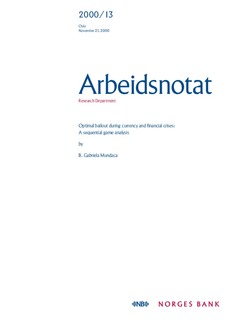| dc.contributor.author | Mundaca, B. Gabriela | |
| dc.date.accessioned | 2018-06-05T12:18:36Z | |
| dc.date.available | 2018-06-05T12:18:36Z | |
| dc.date.issued | 2000 | |
| dc.identifier.isbn | 82-7553-160-8 | |
| dc.identifier.issn | 0801-2504 | |
| dc.identifier.uri | http://hdl.handle.net/11250/2500394 | |
| dc.description.abstract | We present a model that illustrates the close relationship between the possibility of a currency crisis and the amount of private-sector debt within a four-stage sequential game framework. The agents are the government and the private sector in a small economy. In the first stage, the government announces that a fixed exchange rate regime will be pursued, and all agents in the economy receive probabilistic information about a future shock that will occur in the last stage. This shock will affect unemployment and net returns on private sector investment. At this stage, the government can already commit to bailing out part of the private sector liabilities of outstanding stock in the event of a bad shock occurring. We also consider the case where the government waits until the last stage to make decisions about the optimal bailout. The private sector in stage 2 forms expectations about the future exchange rate and engages in risky investments. In stage 3, the government faces costs due to expectations of future devaluation and private-sector debt, anticipating the stochastic shock that will occur in stage 4. In this stage, the government may or may not find it optimal to pre-emptively abandon its fixed exchange rate policy. We find that these decisions to commit or not to commit have very important implications for the government’s optimal decision and expectations formation in the private sector. A commitment to bailing out provides a reconciliation of the multiple equilibria that result from self-fulfilling expectations. It is found that commitment to debt bailouts may discourage speculative attacks, in which case it will never be optimal to devalue, even in the case of losses in investment projects. Thus, the government may sometimes avert currency crises by committing to bailing out. | nb_NO |
| dc.language.iso | eng | nb_NO |
| dc.publisher | Norges Bank | nb_NO |
| dc.relation.ispartofseries | Working Papers;13/2000 | |
| dc.rights | Attribution-NonCommercial-NoDerivatives 4.0 Internasjonal | * |
| dc.rights.uri | http://creativecommons.org/licenses/by-nc-nd/4.0/deed.no | * |
| dc.subject | JEL: E44 | nb_NO |
| dc.subject | JEL: F30 | nb_NO |
| dc.subject | JEL: F41 | nb_NO |
| dc.subject | financial and currency crisis | nb_NO |
| dc.subject | bailouts | nb_NO |
| dc.subject | sequential games | nb_NO |
| dc.subject | multiple and unique equilibrium | nb_NO |
| dc.title | Optimal Bailout During Currency and Financial Crises: A Sequential Game Analysis | nb_NO |
| dc.type | Working paper | nb_NO |
| dc.description.version | publishedVersion | nb_NO |
| dc.subject.nsi | VDP::Samfunnsvitenskap: 200::Økonomi: 210::Samfunnsøkonomi: 212 | nb_NO |
| dc.source.pagenumber | 26 | nb_NO |

